Lubo Kristek
| Lubo Kristek | |
|---|---|
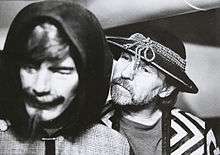 Lubo Kristek in 1997 | |
| Born |
8 May 1943 Brno, Czech Republic |
| Known for | Painting, sculpture, performance art |
| Notable work |
|
| Movement | Assemblage, surrealism, post-modern, happening, avant-garde |
Lubo Kristek (born 8 May 1943[1]) is a sculptor, painter, action artist[2][3] and performer[4] of Czech origin, who lived in West Germany from 1968 until the 1990s,[5] at time that was crucial for him in reaching his artistic maturity.[6]
Life and work
Background of Kristek's work

In dreamlike and fantasy themes, Kristek puts the creative aspect of a Freudian world of unconscious and concrete irrationality into direct opposition with the one-sided, rational, usual and conventional world. Kristek also complies with the basic principle of surrealism – the principle of spontaneous creation of the shape from chaos in which he listens to the stimuli linking man with nature. Kristek opens gates to mental and natural underground resoureces. In his artistic work, there appear a certain unpredictability and seismic activity which allow him to escape from the controlled space. He follows the idea of a total work of art, so called Gesamtkunstwerk.
— Barbora Půtová[7]
In the 1960s, Kristek lived in a ramshackle house, a former soap factory, in Hustopeče, where he gathered artists around him and organised events incorporating music, visual art, poetry, theatre and improvisation.[8] The testing of borders, experiments and crossing the conventional frame were typical for him from the very beginning.[4]
At that time, he also experimented with using fire as a means of expression. It was his dialogue with the unpredictable. He deliberately suppressed or sometimes annulled his artistic handwriting to let the material talk.[9]
The cosmopolitan aspects[10] of Kristek's work and the ability to apply transcultural experience are linked with his emigration to West Germany in 1968.[11] He settled in Landsberg am Lech and lived there for almost three decades.[12] That was also where he started the tradition of Kristek's Night Vernissages, from which his happenings evolved.[13] His studio in Landsberg became his artistic melting pot.
From Landsberg, Kristek travelled to many places in Europe to study (Belgium, Luxembourg, Liechtenstein, the Netherlands, France, Italy, Spain, Republic of San Marino, Switzerland, Austria).[14][11] He explored various countries, enjoyed wandering through the landscape and meeting the inhabitants. These trips and explorations had a special meaning for him and brought him material for his creative work and development.
In 1977, Kristek travelled through the west coast of United States and Canada with his American Cycle 77.[15]
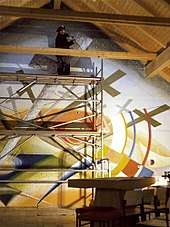
Kristek's work attracted attention. In 1982, the Munich magazine Applaus mentioned some of his striking feats:
In Greifenberg, there is a fountain which he created, in Penzing, he painted the fresco Cross in the cemetery chapel, and on the staircase of the Ignaz Kögler Gymnasium in Landsberg, Kristek's monumental Tree of Knowledge thrusts up through the floors to the skylight. In addition to this, there are sculptures in parks and gardens, reliefs and artistic decorations in many private houses.
— Johanna Kerschner[16]
In 1989, after the Velvet Revolution, Kristek started on a return journey to his native country[6] (he circulated between Germany, the Czech Republic and other countries for some time, but in fact, never lost contact with Germany).[12] He settled in Podhradí nad Dyjí;[6] on the apex of the roof of his studio, he located a sculpture of a piano balancing on one leg.[17] Writer Jaromír Tomeček unveiled the sculpture in 1994 and on the basis of the artwork's title he called the entire neighbouring area of the Thaya Kristek Valley of the Divine Ephemerality of Tone.[18]
The Minister of the culture of the Czech Republic, Václav Jehlička, wrote in this context:
In his manifestations, Kristek balances on a fragile node that joins various styles and means of expression. Even one of his life symbol is such – a piano rearing up on one leg on the top of the roof of his studio in the Czech Republic.[19]
Kristek continued his happening activities. He has so far organised happenings in Germany, the USA, Canada, Italy, Spain, Czech Republic, Austria, Turkey, Belgium, Poland and Slovakia.[20]
In 2005–6, he created Kristek Thaya Glyptotheque, a sculpture pilgrims' way along the river Thaya.[12]
Sculptures and Assemblages

One of Kristek's first artworks, called Vision – Burning of Christ (1964), originated in the house in Hustopeče and shows the artist's testing of material and values. First he created a realistic sculpture of Christ from cast iron, then he put this on a cross in a wooden construction and continued to shape it using flame. The melting material symbolised the relativity of shape, as well as the relativity of "melting" faith in Kristek's home country in the 1960s.
Kristek transforms his assemblages into modern versions of altars and tabernacles.[7] An example is his assemblage Expecting (1969),[21] which is the result of his long debates with his friend Eberhard Trumler (who was a pupil and colleague of the founder of ethology, Konrad Lorenz) about the mechanisms of survival of the species.
The sculpture Soul (1977)[22] also belongs to Kristek's artworks shaped by flame. The sphere that dominates the top is a symbol of artistic heritage that Kristek adopted from his teacher and soulmate, Arno Lehmann.[7] (German artist living in Salzburg, where Kristek used to go to meet him[23])
The large-scale sculpture Tree of Knowledge (1982), rises through three floors of the building and is an example of harmonisation of a sculpture with its surroundings, which Kristek later utilised in his landscape works. Tree of Knowledge is held in high esteem. The Munich magazine Steinmetz + Bildhauer wrote:
Kristek covered the wooden core in strips of noble metal. The fruit of the tree and the branches are also made of metal. (…) It is difficult to imagine a closer and more fruitful unity of art in architecture. Where over the past twenty years in the Rhineland might we find a comparable example in art and architecture?[24]
Kristek has left his artistic footprint in the landscape on the Spanish coast of Cantabria.[19] The assemblage Barbed Wire of Christ (1983) is a pitiful relic of the current mechanised, dehumanised and rationalised world.[7]
In 1986, he created the assemblage Sea Horse from material that was cast out by the sea on the Italian coast. The horse is frozen in time; it has a skull instead of a head, but at the same time, it is a symbol of eternal life motion and a representation of the galloping waves of life as well as the sea.[7]
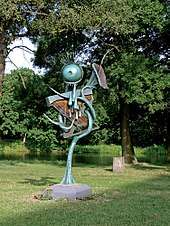
His works of art typically transcend the given frame. For him, the assemblage is a platform for escaping or extending the boundaries of the defined area or even meaning. We can see this in the assemblages Metastation of Abandoned Tones (1975–1976) and On the Landfill of Ages (1994), in which Kristek incorporated musical instruments and strings. These artworks thematically resonate with Kristek's personal life (the former) and with the development of society (the latter), being unique mirrors.
Kristek's metal sculpture Monument to the Five Senses (1991), standing in front of the Neues Stadtmuseum in Landsberg am Lech,[25] became one of Landsberg's landmarks. In 2008, the Bavarian State Minister for Science, Research and Art, Dr. Thomas Goppel, wrote in his foreword for the catalogue Third Eye of Distance Communication:
Also, the Monument to the Five Senses, which was installed in front of the Neues Stadtmuseum in 1992 – a three-meter tall hand with nose, eye, ear and mouth – deserves particular attention. Thus the artist reminds us, during each visit to the museum, that art addresses all the five senses and it should also be perceived by all senses.[26]
Kristek utilises his craft and perfect mastery of the technique especially in metal sculptures:[7]
Just like a medieval artist, Kristek personally welds, grinds and carves his sculptures. From many aspects his free-standing statues represent a surreal parallel with the paintings of the Czech painter Mikuláš Medek (1926–1974), the German painter Max Ernst (1891–1976) and the Spanish painter Salvador Dalí. This is documented in particular by Kristek's metal sculptures Monument to the Five Senses (1991) and Tree of the Aeolian Harp (1992).[7]
In 2007, Kristek presented the form of interactive assemblage Requiem for Mobile Telephones that originated in his happening with the help of the audience and their mobile phones.[3] Kristek then travelled with his happening mission to several countries and the assemblage changed.[19] The project was aimed against addictions to modern technologies and against hidden traps in the modern society.[3] Kristek addressed the subject of traps already in his assemblage Soundproof Aesthetic of Luxuriety in 1976.[2]
In 2015–2017, the artist transformed his house into a monumental assemblage Kristek House.[27]

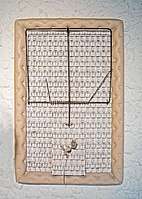
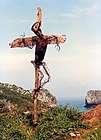


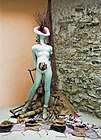
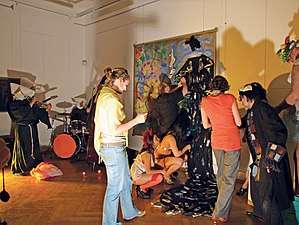

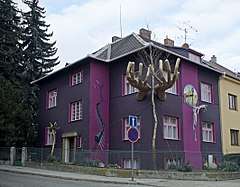
Kristek Thaya Glyptotheque
The first assemblages and sculptures in the landscape prepared the ground for Kristek's magnum opus, the Kristek Thaya Glyptotheque, which he created in the years 2005–2006.[7] It is a pilgrims' way that runs along the river Thaya through the Czech Republic, Austria and Slovakia.[28]
He linked together the sculptures – in which he achieved monumentality, craft qualities and spiritual scope – in a pilgrims' way dedicated to the river Thaya. He invites those who visit his sculptures to take a walk through the landscape.[29]
The route includes eleven symbolic stations, and it became Kristek's open-air sculpture museum.[28] It offers the pilgrim a view into his own inner self and gives an additional dimension to contrast with the predominant consumer lifestyle of our society.[7] The sculptural stations were open by the series of ten Kristek's happenings.[30] The eleventh’s station remains secret as a challenge for the pilgrim.[28]
The grand project which combines a material and spiritual dimension should, according to Kristek, not only support tourism in this poor region but also reinforce people's solidarity with nature. Kristek: ‘it should also be a protection against the devastation of the parent riverbed. If a person experiences culture here, perhaps he will not behave so unkindly to nature.’[31]
Paintings
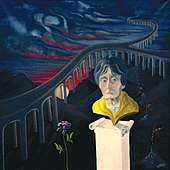
Kristek has created his specific vocabulary in paintings. It is possible to assign particular "attributes" to his symbols. Observation of the content flow of his symbols during the course of time brings a deeper understanding of his art. This symbology soaks through his lifelong work in various media.
As far back as the 1970s, one can find the theme of the bridge and road in his paintings. The artist calls this road, which is mostly bordered by the arches of bridges and which rises and disappears into the unknown, "the heavenly highway".[29] It reflects the desire to make a pilgrimage to spirituality, to connect with things that are greater than us. The oil painting The Heavenly Highway of Aunt Fränzi (1974), which is today part of Neues Stadtmuseum's collection, is an example from the period when this symbol was born in Kristek's mind.[29]
The ballerina or the dancer is the central theme of Kristek's work. She is the dynamic aspect and the carrier of the change. She represents the same form of dynamism in his painting as well as happenings.[7] Kristek's ballerina evolves in time and reflects the development of postmodern society. In the painting Billiards for Life and the Ballerina from 1987, she personifies the vitality in the world of constant metamorphosis.[32]

However in the 2010s, the meaning of the symbol shifts and the ballerina is often the last witness of the destruction. In the happening The Way of the Cross (2014),[33] the triune ballerina in the form of flames consumes all that is left after the destruction (the scene is followed by another Kristek motif, the rebirth). In the painting Peculiar Pole Vault (2016), the ballerina appears as Death. She is cleansing the world of the emptied society of waste.
Another lifelong symbol of Lubo Kristek is the tree with two apples. The tree is naked like the hope that grows from the ashes of society's wasted efforts. It can be found, for example, in the painting Forest Impression (1995), where it grows through an old wagon. It leads to another Kristek theme, that is intergrowth or penetration of forms, as in Suite for Biophilic Piano Attacked by Masochistic Tuba (1995).[34]
On many of Kristek's paintings, an expressively elaborated form of symbolism has matured in which the emphasis is placed on every element of the composition. Nothing here appears by accident, and everything is subject to hidden contents. The work of art expresses the inner psychological states and intensifies their expression with an exaggeration of colour and shape or deformation.[7]
Happenings, Performances
In 1971, Kristek's Night Vernissages and his happenings came into being.[35] It was at these events where he formulated his artistic opinions. There was no entry fee (and entry to Kristek's happenings still remains free today) and they served as a meeting point for sculptors, painters, musicians, poets, philosophers and also the visitors. This environment became the substrate for his happenings.
In 1976, the magazine Collage mapped out the first years of Kristek's Night Vernissages:
It is now five years since Lubo Kristek organised his first night vernissage with no financial support. And the fourth one will be held this year. At them artists from every corner of Germany, Canada, England and the USA meet and exhibit, celebrate and discuss, and they shake the ideologies of garden gnomes to their foundations.[36]
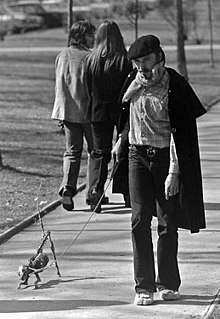
These experiments were at the interface between theatre, music, improvisation and ritual. The immediate experiencing of the moment was crucial for Kristek. The happenings gradually became an independent part of his work. The motifs of death, the illness of society and doom are counterbalanced by birth or rebirth, liberation from shackles and intergrowth of forms. Sometimes it is only Kristek performing as in 1975, when went for a walk with a fox's skeleton on a leash on the famous Landsberg colonnade and observed the reactions of the people (he called the action Promenade with a Neurotic Fox).[37] In other cases the number of event participants reaches hundred as in the happening The Way of the Cross (2014).
Kristek's events can be described as happenings, performances or sometimes even site-specific, but he uses the original expression happening, because the involvement of the public as well as the authentic experience are crucial for him.
This avant-garde artist[38] is known for his critique of consumerism.[39] At the climax of his happening in 2002, he crawled out of bowels of a cow carcass[38] to read his manifest against the destructive and self-destructive tendencies of society.[39]
The artist sometimes completely dissolves the boundary between the auditorium and the stage. In the climax of the happening Visio sequentes or Concerning the Prematurely Cloned Age of One Planet (2003), he dispersed the artists, mentally disabled people, amongst the spectators. They were quite shocked and looked around uncomfortably to find out "who's who?" or "who's the madman here?" Kristek forced the spectator to wonder where the boundary is and whether it exists at all. He wants the spectator not to understand the situation, but to experience it. Kristek's aim is to evoke a threshold situation. The liminality opens the path to transformation. The shocked spectator is shifted outside his own stereotypes and has the possibility to re-evaluate from a point of detachment.[37]
The magazine Medizin + Kunst analyzed Kristek's happenings:
In his artistic process we can see the linkage to Freudian psychoanalysis, his happenings and performances are conducted in the spirit of the so-called 'Activité Paranoique Critique' of Salvador Dalí, and in them the artist has the possibility to develop his uncommon abilities in them and go into a trancelike state – with a wholly unexpected end. (…) Yet at the same time Lubo Kristek looks for the opening of new spaces, he attempts to vibrate the unknown places of the spectators' soul, and the intention of his performance is the force of creation and artistic intuition to even overcome death mentally.[4]
Holographic Perception
Lubo Kristek seeks not only the authentic experience and sharing a common space with the spectators. He goes even further to a specific way of perception, which he calls holographic perception.[37] He doesn't organise scenes in a linear manner, so the flow of events doesn't constitute a connected continuum. On the contrary, there are several different actions happening at the same time during Kristek's event. According to his theory, a far more plastic and holographic picture is formed in the mind of the spectator. The layering of scenes as well as layering of meanings results not in a disruption of the perception, but in its sharpening and emphasises the impact on the emotions, creativity and intuitiveness of the spectators.[37]
Successively Layered Transmedial Artwork
Kristek's works of art in various techniques are not isolated. On the contrary, they are interconnected and sometimes make up a cluster.[4] Lubo Kristek therefore brings the successively layered transmedial artwork.[37] His artwork in one media becomes a means of expression for an artwork in another media.[37]
For example his sculpture Pyramidae-Klipteon became a "prop" for his happening Gateway to the New Dimension (2012)[40], and the artist used the scene from the happening as one of the layers of meaning for his oil painting Landscape of Senses with Supported Clouds (2013).[41]
It is not persumptious to claim that Lubo Kristek is one of the few artists who followed their creative callings now for almost a lifetime and set particularly sustainable momentums.[42]
List of selected works
Sculptures
- 1964 Vision – Burning of Christ
- 1968 Thaya – Destiny of a Tree
- 1977 Soul[43]
- 1977 Birth of the Absolute Form[44]
- 1978 Deliverance from Suffering, ceramic sculpture at the 7th station of Kristek Thaya Glyptotheque near Louka Monastery in Znojmo (Czech Republic)
- 1978 Birth and Simultaneously Damnation of the Sphere,[45] ceramic sculpture in chapel at the 8th station of Kristek Thaya Glyptotheque by Jan’s Castle near Podivin (Czech Republic)
- 1988 The Drinking, bronze fountain for Theresienbad Greifenberg (Germany)
- 1982 Tree of Knowledge, large-scale sculpture (3 floors) for Ignaz-Kögler-Gymnasium, Landsberg am Lech (Germany)
- 1991 Monument to the Five Senses,[46] metal sculpture for Neues Stadtmuseum, Landsberg am Lech (Germany)
- 1992 Tree of the Aeolian Harp,[47] metal sculpture at the 9th station of Kristek Thaya Glyptotheque near Břeclav (Czech Republic)
- 2005–6 Birth, metal sculpture at the 1st station of Kristek Thaya Glyptotheque by the source of the Moravian Thaya near Panenská Rozsicka (Czech Republic)
- 2006 The Seekers,[48] original exhibited at Kristek Hall, Palace Ruegers (Austria)
- 2006 Wishing Stones, composition of seven boulders at the 2nd station of Kristek Thaya Glyptotheque near Stare Hobzi (Czech Republic)
- 2006 Cosmically Timed Parapyramidal Potency,[49] painted metal monument at the 4th station of Kristek Thaya Glyptotheque in Podhradí nad Dyjí (Czech Republic)
- 2015 The Seekers – Organic Forms, metal sculpture at the 10th station of Kristek Thaya Glyptotheque on the confluence of the rivers Thaya and Morava near Sekule (Slovakia)
Assemblages
- 1969 Expecting[50]
- 1969 The Flyer[51]
- 1973 Window of Sins
- 1975–76 Metastation of Abandoned Tones,[52] exhibited at Kristek Hall, Palace Ruegers (Austria)
- 1976: Soundproof Aesthetic of Luxuriety
- 1983 Barbed Wire of Christ,[53] Cantabria (Spain)
- 1986 Sea Horse,[54] Rome (Italy)
- 1989 Gloria, Birth of Homo Divinensus – Intelektes[55]
- 1975–92 Automatic Trains of Thought – Desk,[56] exhibited at Chateau Lubo, Podhradí nad Dyjí (Czech Republic)
- 1992 Door, this work of art originated during the happening Space of Soul (1992) in Landsberg am Lech[57]
- 1994 On the Landfill of Ages,[58] exhibited at Kristek Hall, Palace Ruegers (Austria)
- 1994 Family with the Invisible Man[59]
- 1998 Sensual Frequencies, for the town hall Bursa (Turkey)
- 2000 Arachnologia Adé,[60] Kristek's tribute to his beloved spiders
- 2001 Conception by Time[61]
- 2003 In the Prematurely Cloned Age of One Planet[62]
- 2007 Preludes of Franz Liszt[63]
- 2007–10 Requiem for Mobile Telephones[64]
- 2010 The Last Gate, exhibited at Chateau Lubo, Podhradí nad Dyjí (Czech Republic)
- 2010 EU 2010 – The Stubborn Attempts of the Paraplegic Bloody Goblin,[65] exhibited at Chateau Lubo, Podhradí nad Dyjí (Czech Republic)
- 2017 Kristek House, Brno (Czech Republic)
Paintings
- 1974 The Heavenly Highway of Aunt Fränzi,[66] oil on canvas, one of the first painting with Kristek's symbolical heavenly highway, Neues Stadtmuseum, Landsberg am Lech (Germany)
- 1974 Watching the Earth,[67] secco painting on the façade, Augsburg (Germany)
- 1975–76 All-sided High Tension[68]
- 1976 Critical Defloration of Soul[69]
- 1977 Joint Tension with an Accent on the Black Hole,[70] wall painting, Los Angeles (USA)
- 1977 Heat – Life – Eternity,[71] façade, painting, acrylic-polymer emulsion, San Francisco (USA)
- 1977 Transcendental Composition between Suffering and Hope,[72] wall altar made for the chapel in Penzing (Germany)
- 1978–82 The Moss-grown Phone Call[73]
- 1995 Suite for Biophilic Piano Attacked by Masochistic Tuba[74]
- 1995 Forest Impression[75]
- 1976–2000 Where Only Birds Can Fly[76]
- 1996 Naděžda's Accord in the Landscape[77]
- 2003 Latent Flight to the Seventh Dimension[78]
- 2003 Desert Madonna[79]
- 2009 Cemetery Sleeping Beauty, autoportrait[80]
- 2016 Peculiar Pole Vault
Happenings
- 26. July 1973 Kristek's Night Vernissage, Kristek's studio, Landsberg am Lech (Germany)
- 26. July 1975 Kristek's Night Vernissage, Kristek's studio, Landsberg am Lech (Germany)
- 31. July 1976 Kristek's Night Vernissage, Kristek's studio, Landsberg am Lech (Germany)
- 11. June 1977 American Cycle 77, Beyond Baroque Gallery, Los Angeles (USA)[81]
- 12. September 1977 American Cycle 77, Vancouver Multicultural Society, Vancouver (USA)[82]
- 30. August 1983 Rebirth of Kristek's Fantasy, Kleinkitzighofen (Germany)[83][84]
- 24 February 1989 Adé Dalí, Müssiggengelzunfthaus, Kempten, Germany (Germany), tribute to Salvador Dalí, with whom Kristek was in contact mostly in the 1970s[85]
- 12. December 1992 Space of Soul, Neues Stadtmuseum, Landsberg am Lech (Germany)
- 30. July 1994 Full of Tones, Freistein ruin, Podhradí nad Dyjí (Czech Republic)[17]
- 12. August 1995 Mythologic Landscape No. 95 in Three Acts, river Thaya, Podhradí nad Dyjí (Czech Republic)[86]
- 27. July 1996 The Burial of the Seven-Sin Heritage or Where Evrum is Born, happening on the cemetery, Podhradí nad Dyjí (Czech Republic)[87]
- 20. and 26. June 1998 Love in circulo vitioso in finito secundi milenii, double-happening – town square, Landsberg am Lech (Germany), Kraví hora, Brno (Czech Republic)
- 6. November 1998 Sensual Frequencies, pedestrian area in front of the town hall, Bursa (Turkey)
- 1. July 2000 Opening of Kristek's Park, Podhradí nad Dyjí (Czech Republic)
- 28. March 2001: Arachnologia adé, Podhradí nad Dyjí (Czech Republic)[88]
- 4. August 2001 The Conception of Time or Sarcophagus of Dreams, Chateau Lubo, Podhradí nad Dyjí (Czech Republic)
- 10. November 2001 Space of Soul II, City Theatre, Hasselt (Belgium)
- 1. June 2002 Pyramidae-Klipteon II, in front of Chateau Lubo, Podhradí nad Dyjí (Czech Republic)[39]
- 4. July 2003 Visio sequentes or Concerning the Prematurely Cloned Age of One Planet, underground of the Znojmo Castle (Czech Republic)[89]
- 20. – 22 May. July 2006 – Kristek Thaya Glyptotheque, opening of the pilgrimage sites, ten happenings in Czech Republic, Austria and Slovakia[30]
- 13. April 2007 Requiem for Mobile Telephones I, Znojemský deník Rovnost, Znojmo (Czech Republic)
- 24. April 2007 Requiem for Mobile Telephones II, Mariahilfer Strasse, Vienna (Austria)
- 16. May 2007 Requiem for Mobile Telephones III, Barockschloss Riegersburg (Austria)
- 10. May 2008 Third Eye of Distance Communication or Requiem for Mobile Telephones IV, Neues Stadtmuseum, Landsberg am Lech (Germany)
- 16. August 2008 The Phylogenetic Very Wet Wedding or How the Weary World of People Returns to the Watery Depths, Jan's Castle (Czech Republic)
- 28. April 2009 Fall of the Iron Curtain, Barockschloss Riegersburg (Austria)
- 5. June 2010 Requiem for Mobile Telephones V, Muzeum Miejskie, Sucha Beskidzka (Poland)
- 1. November 2012 Gatewey to the New Dimension, Sychrov Castle (Czech Republic)
- 25. May 2013 Surreal Cacophony, Jan's Castle (Czech Republic)
- 14. September 2013 Testimony about the Soul, Horacke Theatre, Jihlava (Czech Republic)
- 7. June 2014 The Way of the Cross, Landstejn Castle (Czech Republic)
- 28. April 2015 In the Captivity of Blue Tango, Barockschloss Riegersburg (Austria)
- 15. August 2015 The Seekers – Organic Forms, confluence of the rivers Thaya and Morava
- 30. September 2015 The Hunt, Chateau Krtiny (Czech Republic)
References
- ↑ "Tip na víkend: Křížová cesta v Landštejně". divadelni-noviny.cz (in Czech). Divadelní noviny (Theatre Newspaper). 2 June 2014. Retrieved 5 March 2018.
- 1 2 Půtová 2018, Chapter: Meeting place – Introduction
- 1 2 3 Půtová 2018, Chapter: Meeting place – Requiem for Mobile Telephones
- 1 2 3 4 Kerschner, Johanna (1994). "Landschaften Räume der Seele von Lubo Kristek". Medizin + Kunst: Das Kunstmagazin für den Arzt in Praxis und Klinik (in German). No. 3. pp. 20–22.
- ↑ Neunzert 2008, p. 3,5.
- 1 2 3 Dufek, Jaromir (16 July 1993). "Cesticky Lubo Kristka". Svobodne slovo (in Czech). p. 4.
- 1 2 3 4 5 6 7 8 9 10 11 Půtová 2018, Chapter: Lubo Kristek: The Sun King in the Theatre of His Own World
- ↑ Smola, Vojtech (24 August 2016). "Moje jizni Morava". Deník (in Czech). p. 5.
- ↑ Půtová 2013, p. 21.
- ↑ "Lubo Kristek feiert die Kunst des Happenings" (in German). Augsburger Allgemeine. 8 June 2013. Retrieved 8 March 2018.
- 1 2 Jurgeleit 1986, p. 71.
- 1 2 3 Neunzert 2008, p. 6.
- ↑ Lubo Kristek: Schlösschen Lubo (in German). Brno: VÚKU. 2010. ISBN 9788025479773.
- ↑ Schwabe 1977, p. 16.
- ↑ American cycle 77 2011.
- ↑ Kerschner, Johanna (1982). "Lubo Kristek in Landsberg". Applaus: Münchner Kultur-Magazin (in German). No. 12. p. 80.
- 1 2 Kresse, Ina (3 August 1994). "Einen Karren voller klänge mitgebracht". Landsberger Tagblatt (in German). p. 19.
- ↑ Lubo Kristek: Happening-Schaffen im Thayatal 2013.
- 1 2 3 Foreword by Václav Jehlička in: Neunzert 2008, p. 4.
- ↑ Lubo Kristek Channel
- ↑ Published in Schwabe 1977, p. 10.
- ↑ Published in Schwabe 1977, p. 9 and in Půtová 2018 Online
- ↑ Schwabe 1977, p. 16.
- ↑ "Kunst und Bau". Steinmetz + Bildhauer (in German). No. 5. 1982. p. 396.
- ↑ Tzschaschel 2015, p. 80.
- ↑ Foreword by Thomas Goppel in: Neunzert 2008, p. 3.
- ↑ "Dům performera Kristka bude dějištěm filmu". Ceskatelevize.cz (in Czech). Česká televize. 6 December 2017. Retrieved 5 March 2018.
- 1 2 3 Mitlenerová, Silvie (10 March 2014). "Jedenácté zastavení si musí každý najít sám". iForum: Charles University Online Magazine (in Czech). Charles University. Retrieved 5 March 2018.
- 1 2 3 Půtová 2018, Chapter: Stations of the Glyptotheque – Introduction
- 1 2 Lubo Kristek: Happening-Schaffen im Thayatal 2013, pp. 34–35.
- ↑ Strecha, Frantisek (8 June 2005). "Sochar Lubo Kristek plánuje navléknout Dyjí devet korálku". Rovnost (in Czech). p. 7.
- ↑ Schlösschen Lubo, p. 27.
- ↑ Happening The Way of the Cross – video
- ↑ Published in Půtová 2018 Online
- ↑ Neunzert 2008, p. 6.
- ↑ Mueller, Sven (1976). "Das kunstvolle Leben des Bildhauers: Lubo Kristek". Collage: Zeitschrift für Literatur und Grafik (in German). No. 3. p. 30.
- 1 2 3 4 5 6 Půtová 2018, Chapter: History and Happenings – Introduction
- 1 2 "Lubo Kristek, surrealisticky demon z Pohradi". Denik.cz (in Czech). 7 July 2008. Retrieved 6 August 2018.
- 1 2 3 Smola, Daniel (4 July 2002). "Vesnici sokoval nocní happening". MF DNES (in Czech). p. 9.
- ↑ Happening Gateway to the New Dimension – video
- ↑ Published in Půtová 2018 Online
- ↑ Foreword by Hartfrid Neunzert in: Neunzert 2008, p. 5.
- ↑ Published in Schwabe 1977, p. 9.
- ↑ Published in American cycle 77 2011, p. 9.
- ↑ Published in Neunzert 2008, p. 12.
- ↑ Published in Neunzert 2008, p. 8.
- ↑ Published in Neunzert 2008, p. 9.
- ↑ Published in Neunzert 2008, p. 13.
- ↑ Published in Neunzert 2008, cover.
- ↑ Published in Schwabe 1977, p. 10.
- ↑ Published in Schwabe 1977, p. 11.
- ↑ Published in Schwabe 1977, p. 12.
- ↑ Published in Půtová 2013, p. 12.
- ↑ Published in Půtová 2013, p. 14.
- ↑ Published in Neunzert 2008, p. 32.
- ↑ Published in Neunzert 2008, p. 30.
- ↑ Kerschner, Johanna (1994). "Landschaften Räume der Seele von Lubo Kristek". Medizin + Kunst: Das Kunstmagazin für den Arzt in Praxis und Klinik (in German). No. 3. p. 22.
- ↑ Published in Neunzert 2008, p. 23.
- ↑ Published in Neunzert 2008, p. 36.
- ↑ Published in Půtová 2013, p. 20.
- ↑ Published in Neunzert 2008, p. 31.
- ↑ Published in Neunzert 2008, p. 35.
- ↑ Published in Neunzert 2008, p. 38.
- ↑ Published in Neunzert 2008, p. 39.
- ↑ Published in Půtová 2013, p. 131.
- ↑ Published in Půtová 2013, p. 174.
- ↑ Published in Půtová 2013, p. 33.
- ↑ Published in Neunzert 2008, p. 16.
- ↑ Published in Neunzert 2008, p. 17.
- ↑ Published in American cycle 77 2011, p. 5.
- ↑ Published in American cycle 77 2011, p. 4.
- ↑ Published in Půtová 2013, p. 33.
- ↑ Published in Neunzert 2008, p. 15.
- ↑ Published in Půtová 2013, p. 166.
- ↑ Published in Půtová 2013, p. 173.
- ↑ Published in Neunzert 2008, p. 20.
- ↑ Published in Neunzert 2008, p. 19.
- ↑ Published in Půtová 2013, p. 162.
- ↑ Published in Neunzert 2008, p. 21.
- ↑ Published in Půtová 2013, p. 169.
- ↑ American cycle 77 2011, p. 6.
- ↑ American cycle 77 2011, p. 8–9.
- ↑ "Reich der Phantasie an die Macht". Buchloer Zeitung – Allgäuer Zeitung (in German). 2 August 1983. p. 16.
- ↑ "Stadtmuseum Landsberg am Lech: Lubo Kristek – Künstler und Weltbürger". Europadruck.com (in German). 2008. Retrieved 8 March 2018.
- ↑ Tzschaschel 2015, p. 81
- ↑ "Noc po svatém Vavrinci". Rovnost (in Czech). 17 August 1995. p. 8.
- ↑ Jurák, Petr (29 July 1996). "Happeningu naslouchal v hrobe". Rovnost (in Czech). p. 9.
- ↑ Petrak, Jiri (29 March 1996). "Lubo Kristek znovu prekvapil originálním odhalením díla". Rovnost (in Czech). p. 8.
- ↑ "Tief in den Katakomben". Kreisbote (in German). 9 July 2003.
Bibliography
- Schwabe, Nick (1977). Lubo Kristek: Individual Visions of Sculptures from the Last 8 Years, 1968–1976 (PDF). Vancouver.
- Jurgeleit, Peter; Hellerer, Frederike; Hellerer, Heinz (1986). Schwäbische Künstlerprofile / 1. Allgäu, Bayerisches Schwaben (in German). Herrsching: Vorlag Fredrike Hellerer. ISBN 3925976000.
- Neunzert, Hartfrid (2008). Lubo Kristek: Third Eye of Distance Communication. Landsberg am Lech: Neues Stadtmuseum.
- Schlösschen Lubo: Auswahl aus der Sammlung des Schlösschens Lubo quer durch die Geschichte (in German). Brno: VÚKU. 2010. ISBN 9788025479773.
- Lubo Kristek: American Cycle 77, Philosophical Approach to the Questions of Form (selected works). Brno: VÚKU. 2011. ISBN 9788025498453.
- Půtová, Barbora (2013). Kristek's Glyptothek im Thayatal (in German). Brno: VÚKU. ISBN 9788090554818.
- Lubo Kristek: Happening-Schaffen im Thayatal (in German). Brno: VÚKU. 2013. ISBN 9788090554801.
- Tzschaschel, Hans-Jürgen (2015). Schätze aus den städtischen Sammlungen des neuen Stadtmuseums Landsberg am Lech (in German). Landsberg am Lech: Freundeskreis der städtischen Museen Landsberg e.V. OCLC 946758642.
- Půtová, Barbora (2018). Kristek Thaya Glyptotheque (1st Digital ed.). Research Institute of Communication in Art. ISBN 9788090554832. Retrieved 7 February 2018.